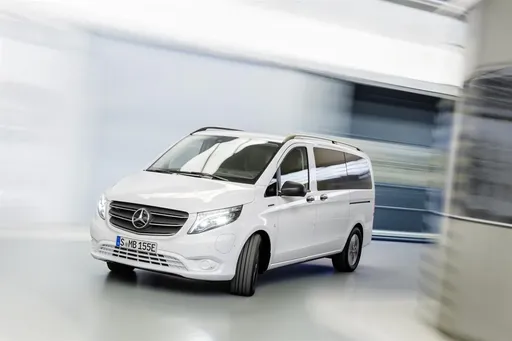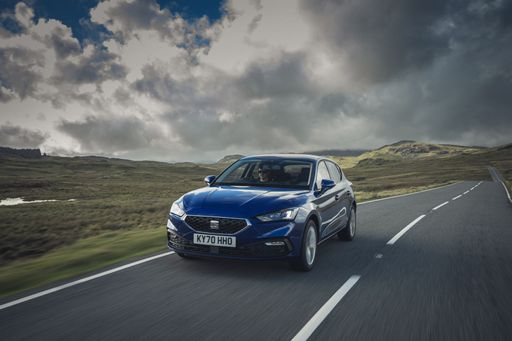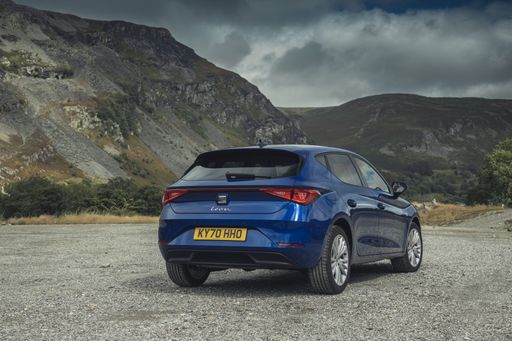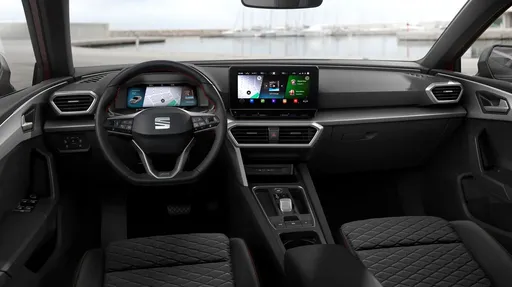Mercedes Vito Bus VS SEAT Leon – Specs, Efficiency & Price Comparison
Which model is the better choice – the Mercedes Vito Bus or the SEAT Leon? We compare performance (237 HP vs 272 HP), boot capacity (1390 L vs 380 L), efficiency (26.70 kWh6.70 L vs 0.40 L), and of course, the price (36300 £ vs 24500 £).
Find out now which car fits your needs better!
The Mercedes Vito Bus (Bus) is powered by a Diesel, Electric or Petrol engine and comes with a Manuel or Automatic transmission. In comparison, the SEAT Leon (Hatchback) features a Petrol, Petrol MHEV, Diesel or Plugin Hybrid engine and a Manuel or Automatic gearbox.
When it comes to boot capacity, the Mercedes Vito Bus offers 1390 L, while the SEAT Leon provides 380 L – depending on what matters most to you. If you’re looking for more power, you’ll need to decide whether the 237 HP of the Mercedes Vito Bus or the 272 HP of the SEAT Leon suits your needs better.
There are also differences in efficiency: 26.70 kWh6.70 L vs 0.40 L. In terms of price, the Mercedes Vito Bus starts at 36300 £, while the SEAT Leon is available from 24500 £.
Compare all the key specs now and find out which model fits your lifestyle best!
Mercedes Vito Bus
The Mercedes-Benz Vito Bus offers a versatile solution for those in need of spacious and comfortable group transportation. Its refined interior is designed to enhance passenger comfort, making it ideal for both business and leisure travel. With a focus on safety and efficiency, it provides a reliable driving experience that aligns with the high standards expected of the Mercedes-Benz brand.
details
SEAT Leon
The SEAT Leon impresses with its dynamic design and sporty edge, making it a standout choice in its class. Its interior is characterised by a modern, driver-focused cockpit that combines functionality with an emphasis on comfort. The car delivers a responsive driving experience, thanks to its advanced engineering and agile handling capabilities.
details @ seatmedia
@ seatmedia
 @ seatmedia
@ seatmedia
 @ seatmedia
@ seatmedia
 @ seatmedia
@ seatmedia

|

|
|
|
|
Costs and Consumption |
|
|---|---|
|
Price
36300 - 59000 £
|
Price
24500 - 35700 £
|
|
Consumption L/100km
6.7 - 10 L
|
Consumption L/100km
0.4 - 5.7 L
|
|
Consumption kWh/100km
26.7 - 26.9 kWh
|
Consumption kWh/100km
-
|
|
Electric Range
248 - 370 km
|
Electric Range
133 km
|
|
Battery Capacity
60 - 90 kWh
|
Battery Capacity
19.70 kWh
|
|
co2
0 - 228 g/km
|
co2
8 - 129 g/km
|
|
Fuel tank capacity
57 - 70 L
|
Fuel tank capacity
40 - 45 L
|
Dimensions and Body |
|
|---|---|
|
Body Type
Bus
|
Body Type
Hatchback
|
|
Seats
8
|
Seats
5
|
|
Doors
4
|
Doors
5
|
|
Curb weight
2023 - 2739 kg
|
Curb weight
1344 - 1670 kg
|
|
Trunk capacity
580 - 1390 L
|
Trunk capacity
270 - 380 L
|
|
Length
4895 - 5370 mm
|
Length
4368 mm
|
|
Width
1928 mm
|
Width
1799 mm
|
|
Height
1890 mm
|
Height
1442 - 1460 mm
|
|
Payload
726 - 1077 kg
|
Payload
460 - 521 kg
|
Engine and Performance |
|
|---|---|
|
Engine Type
Diesel, Electric, Petrol
|
Engine Type
Petrol, Petrol MHEV, Diesel, Plugin Hybrid
|
|
Transmission
Manuel, Automatic
|
Transmission
Manuel, Automatic
|
|
Transmission Detail
Schaltgetriebe, Automatikgetriebe
|
Transmission Detail
Schaltgetriebe, Automat. Schaltgetriebe (Doppelkupplung)
|
|
Drive Type
Rear-Wheel Drive, All-Wheel Drive, Front-Wheel Drive
|
Drive Type
Front-Wheel Drive
|
|
Power HP
136 - 237 HP
|
Power HP
110 - 272 HP
|
|
Acceleration 0-100km/h
-
|
Acceleration 0-100km/h
7.7 - 10.5 s
|
|
Max Speed
140 km/h
|
Max Speed
197 - 220 km/h
|
|
Torque
330 - 500 Nm
|
Torque
220 - 360 Nm
|
|
Number of Cylinders
4
|
Number of Cylinders
4
|
|
Power kW
100 - 174 kW
|
Power kW
85 - 200 kW
|
|
Engine capacity
1950 - 1999 cm3
|
Engine capacity
1498 - 1968 cm3
|
General |
|
|---|---|
|
Model Year
2024
|
Model Year
2024 - 2025
|
|
CO2 Efficiency Class
G, A
|
CO2 Efficiency Class
D, B
|
|
Brand
Mercedes-Benz
|
Brand
SEAT
|
Mercedes Vito Bus
The Mercedes Vito Bus: A Comprehensive Look at Innovation and Performance
In the automotive world, the Mercedes Vito Bus stands out as a versatile and reliable choice for those in need of a spacious and efficient mode of transport. With a reputation for engineering excellence, Mercedes-Benz has once again delivered with the latest versions of the Vito Bus. This article delves into the technical aspects, innovations, and what makes the Vito Bus a prime option in its segment.
Engine Power and Efficiency
The Mercedes Vito Bus offers a remarkable range of engine configurations, catering to both diesel and electric powertrains. The diesel models come with options ranging from 136 HP to a powerful 237 HP. The robust four-cylinder diesel engines are designed for efficiency, offering a range of fuel consumption figures from 6.7 L to 7.8 L per 100 kilometers, depending on the variant. Meanwhile, the electric eVito Tourer provides an impressive alternative with a power output of 204 HP and offers ranges of up to 371 kilometers on a single charge, making it a frontrunner in sustainable transportation solutions.
Transmission and Drivetrain Options
The Vito Bus is equipped with both manual and automatic transmission options, ensuring a drive tailored to user preferences. The 9G-TRONIC automatic gearbox is notable for its smooth transitions, enhancing the driving experience. Customers can choose between rear-wheel drive and the adaptable all-wheel drive system. The introduction of the eVito Tourer's front-wheel drive system further expands the versatility of the lineup, offering an electric alternative for urban and rural environments alike.
Interior Comfort and Practicality
The interior of the Vito Bus is designed with comfort and convenience in mind. Capable of seating up to eight passengers, the spacious cabin is ideal for family travel or business transportation. The Vito Bus offers three body lengths—kompakt, lang, and extralang—providing flexibility to accommodate different passenger and cargo requirements. The well-thought-out design ensures ample storage with trunk capacities ranging up to 1,390 liters in certain configurations.
Advanced Innovations
Mercedes-Benz has equipped the Vito Bus with a host of advanced technological features. The focus on safety is evident, with systems like Crosswind Assist and Attention Assist, ensuring greater control and alertness on the road. The eVito Tourer comes with the latest in electric vehicle technology, including efficient battery management systems that optimize range and performance.
Performance and Dynamics
The Vito Bus showcases impressive performance metrics across its variants. With a maximum torque ranging from 330 Nm to 500 Nm, the Vito Bus ensures a responsive and agile driving experience. The consistent build quality and dynamic chassis contribute to a pleasing ride, whether navigating city streets or cruising on the highway.
Conclusion
The Mercedes Vito Bus continues to be a leading choice for those looking for a reliable and performance-oriented vehicle. With its diverse range of engine options, innovative features, and versatile configurations, the Vito Bus meets the demands of both personal and professional transportation. The introduction of electric variants highlights Mercedes-Benz's commitment to sustainability without compromising on power or range. As the automotive industry continues to evolve, the Vito Bus exemplifies the blend of traditional excellence and forward-thinking innovation.
SEAT Leon
The SEAT Leon: A Blend of Performance and Innovation
The SEAT Leon has firmly established itself as a standout model, blending sleek aesthetics with cutting-edge technology. Known for its versatility and dynamic performance, this hatchback has become a staple choice for drivers seeking style and substance. Join us as we delve into the technical intricacies and innovative features that make the SEAT Leon a formidable contender in its class.
Dynamic Engine Options
The SEAT Leon offers a diverse range of engine choices, catering to various driving preferences. From efficient petrol options with mild-hybrid technology to powerful diesel engines, the Leon provides an impressive power range between 110 to 204 PS. Drivers can also opt for the environmentally friendly plug-in hybrid, featuring a 1.4 e-HYBRID powertrain that boasts a consumption rate as low as 1.1 L/100km and an electric range of up to 63 km.
Advanced Transmission Systems
Optimising driving efficiency, the SEAT Leon is available with both a manual gearbox and an advanced automatic dual-clutch transmission (DSG). The DSG offers seamless gear changes, enhancing the driving experience by providing precise control and improved fuel economy. This versatility allows the Leon to cater to drivers who appreciate the traditional feel of manual shifting and those who prefer the convenience of automatic transmissions.
Intelligent Design and Comfort
The SEAT Leon’s interior is designed with the modern driver in mind. Sporting a spacious cabin accommodating up to five passengers, it provides a balance of comfort and functionality. The boot space ranges from 270 to 380 litres, ensuring ample room for luggage. The Leon's ergonomic layout, coupled with optional advanced features such as ambient lighting and premium upholstery, positions it as a leader in comfort and practicality.
Cutting-edge Technology and Safety
The SEAT Leon is not just about performance; safety features prominently in its design. It is equipped with the latest driver assistance systems, such as adaptive cruise control and lane-keeping assist, ensuring a safer driving experience. The infotainment system offers seamless connectivity, supporting both Android Auto and Apple CarPlay, enabling drivers to stay connected while on the road.
Efficiency and Sustainable Driving
Emphasising sustainability, the SEAT Leon offers CO2 emissions ranging from 25 to 132 g/km, showcasing its commitment to environmental responsibility. Fuel consumption varies between a thrifty 1.1 to 5.8 L/100km, catering to both eco-conscious drivers and those focused on performance. With a competitive price range, the Leon stands out as an economical choice in its segment, balancing initial cost and long-term benefits.
Conclusion
The SEAT Leon continues to set benchmarks with its combination of style, performance, and technological innovation. Its array of engine options, advanced safety features, and luxurious interior make it a compelling choice for modern drivers. Whether you prioritise fuel efficiency, power, or comfort, the SEAT Leon offers a tailored driving experience unmatched in its class.
The prices and data displayed are estimates based on German list prices and may vary by country. This information is not legally binding.
